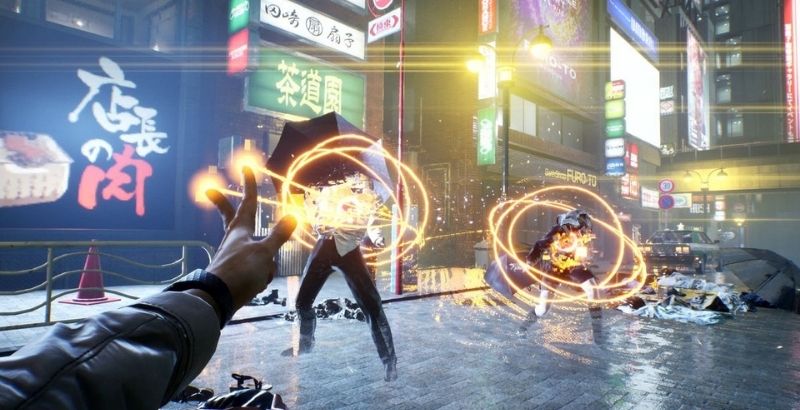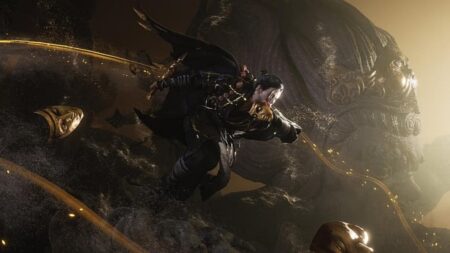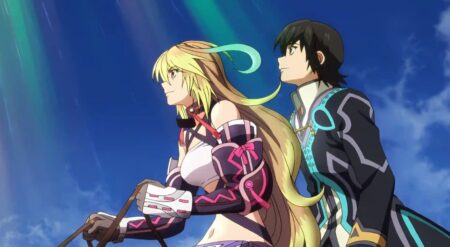
Published by Bethesda Softwork, Ghostwire: Tokyo is the first foray into the action-adventure genre by developer Tango Gameworks. With the cult favorite third-person survival horror moving to a first-person shooter-lite game with Tokyo as its backdrop, Ghostwire: Tokyo had me excited. However, did this game that had key site departures live up to the hype? Did it live up to what the trailers promised: thrills and scares?
In Ghostwire: Tokyo, you play as Akito. After experiencing a fatal accident, he wakes up now possessed by a detective’s spirit, named KK, looking to stop a massive supernatural threat. A threat that has knocked over 240,000 souls out of their bodies and created a night of the living dead scenario full of horrors from Japanese folklore, or “Visitors.” However, to the shock of Akito, someone he loves might be right at the center of it. And so, the unlikely duo of KK and Akito begin their mission to save every trapped soul and stop the Visitors and put an end to whatever threat may be leading to the end of the world.
I’ll be honest, the story’s concept was what kept me going. I was hoping there would be some grand payoff at the end, but I never felt like I got one. At least one that felt satisfying. By the time I rolled credits, I couldn’t care less about why I was playing. Rather, I was only playing for the slowly growing relationship between Akito and KK. There isn’t any real feeling that you’re working towards the finale. What you’re preparing to fight just feels like another big threat.
Tokyo is the biggest win for Tango Gameworks. I didn’t realize this game would be open-world; I was really shocked by its detail. It’s easy to tell that the team cares about their city and wants to give it the respect they thought it deserved. Not only that, there are little details everywhere that feel like nice touches. For example, when the inhabitants of this area lost their bodies, it was like the Rapture. POOF. Everyone is gone, except their clothes. Just looking around, you can see what people were doing in their final moments based on where their clothes are. And the world for how great it is made also serves well to support the main objectives.
The objectives of this game can feel daunting and straightforward at a time. I’ll dive into each later but they break down like this. First, stop the ever-present threat that kicked off this supernatural rapture. The threat is interestingly never letting you forget that he’s here and is trying to shape the world using all these spirits. About every 10 minutes, the big bad pops up on every ad screen in Tokyo while causing the rain to fall upwards just to remind you he’s here. It’s an interesting tactic that reminds you of his power… even if his power means nothing by the end of the game when you do fight him. As for that, there are several side objectives including freeing every trapped soul, helping spirits with their final tasks so they can move on (side missions), and finding Tanuki and prayer statues to help KK and Akito improve their combined abilities. As I said, it’s a lot but it’s also simple.
Also, this world is like a dream for those looking for a new checklist game. The amount of collectibles littered throughout Tokyo is surprisingly impressive, even if they’re not that fun (read: borderline tedious) to collect. Those 240,000 souls are trapped, and one of the tasks you’re given is to free them. You use katashiro, or Japanese paper dolls used for purification, to do this. Great idea… poor implementation. There is a set limit you can carry. Even though you can buy more, why have spirits be collected in the 100s when you have a very small limit of katashiro you can carry at once?! Then, the only way to turn them in (until later) is through the use of telephone booths scattered throughout the city. It’s an exhausting layer on an already tedious task. At least they’re a good source of experience and quick money.
There is just so much tediousness in just about every part of the world. Want to find statues to pray at and get more charges for your attacks? You need to pay very close attention to an audio cue that sounds surprisingly close to the main objective audio cue. Want to find hidden Tanuki in a massive area? You best be ready to talk to every cat or dog to find a possible hint at where they’re hiding. But, again, there is so much to do that it is easy to get distracted… they’re just not good distractions.

Tango Gameworks is known for the creepy and scary. I was severely disappointed that there was little of both. In my entire playtime, I got scared once, and that was during a sidequest. The Visitors have creepy galore. But that’s really about it. If given the time, the side quests fill that void, but should the scares be relegated to side quests? It’s a real shame.
This leads to my next point. My overall feeling of Ghostwire: Tokyo is that there are many good and interesting ideas here. But, unfortunately, most of them just feel like they needed another couple of months to a year to get right. I want to leave the emphasis on “most,” though. Besides the relationship between Akito and KK, which can get repetitive during long playtime because of the overused chatter, the visualized Tokyo is amazing!
The combat may be the most consistent part of Ghostwire: Tokyo. Coming off of the preview, I hoped the movement would get better closer to launch. Sadly, it didn’t. But I got used to not only the sluggish movement but the blocking. I said before that this game needs a dash to help avoid attacks. I stand by that still. The block, though, isn’t as bad as I originally thought. The combat is flashy with the three different elements and bow and arrow. Tack on a big block that feels impactful when you hit it at the right time, and it all almost makes up for how slow Akito feels when moving around. Plus, the flashiness never felt like it got old to me. Adding on an intense finisher that requires you to stay in the Visitor’s faces? It creates a satisfying mix.
Each attack has a charged version that does more to reveal a Visitor’s core, which lets you quickly take them out fast with a core grab or takedown. It is so slow at first that it almost doesn’t feel worth it. Therefore, I’d recommend upgrading charge times the first chance you get. Thankfully these upgrades are cheap, so I suggest saving up and knocking these out first. Then, move on to the takedowns. Specifically, the ground takedown. One thing that feels unspoken is how you need to stay in the fight. You can’t just whittle down the Visitors to survive. Even if Akito has deeper pockets than Mary Poppins’ purse full of food, the best way to get through the many battles is to be aggressive. You get a small HP boost and some ammunition to perform ethereal weaving with each takedown (as well as enemies taken out sooner while using fewer charges).
There is also one minigame that just didn’t work for me about half the time. You have to “cleanse” a spirit or an object every now and then. This involves using hand signs that KK shows Akito. You can do this by using the right analog stick or the touchpad. I found this feature to be the most tedious out of all of them. I had to use a new controller to make sure the one I was using wasn’t busted just because of how unresponsive this feature was.
Another part of combat that felt poorly implemented was KK being ripped out of Akito’s body. Without KK, Akito can’t use ethereal weaving anymore. The first implementation of this is awesome. Akito is alone in Tokyo and can only defend himself with a bow and arrow. You need to find KK and get him back. Those 30 minutes were terrifying for me. I hate feeling defenseless, and that’s exactly what those moments were for—to show that Akito and KK need each other to make it through this. But it quickly becomes a combat mechanic where enemies can rip KK out of Akito. However, KK sometimes goes nowhere, and you can reclaim him faster than the animation of riping him out. This happened to me three times, but each time felt like a weird annoyance that just didn’t feel unnecessary. Why is he right next to me? Why is the speed to grab him faster than an enemy’s attack animation? Again, interesting concept… just needed more time to be implemented well.
Ghostwire: Tokyo offers a lot of good but it’s hidden behind even more tedium. I’m left wishing that the team had more time to polish their ideas. It’s hard for me to recommend Ghostwire: Tokyo. That isn’t to say I didn’t have fun with what’s well made. What doesn’t, though, feels like it was patched instead of fixing the larger issues, which ultimately bogged down my experience.
Ghostwire: Tokyo is available on March 25, 2022, for PlayStation 5 and PC.
Ghostwire: Tokyo
-
Rating - 7/107/10
TL;DR
Ghostwire: Tokyo offers a lot of good but it’s hidden behind even more tedium. I’m left wishing that the team had more time to polish their ideas. It’s hard for me to recommend Ghostwire: Tokyo. That isn’t to say I didn’t have fun with what’s made well. What doesn’t, though, feels like it patches and ultimately bogged down my experience.







